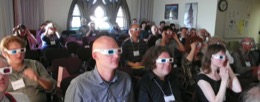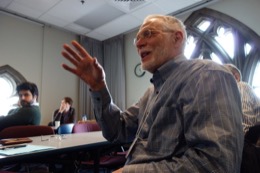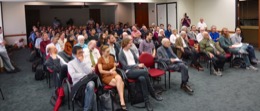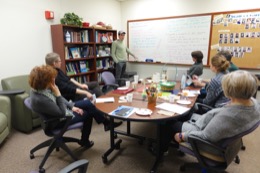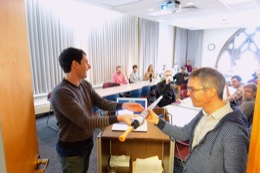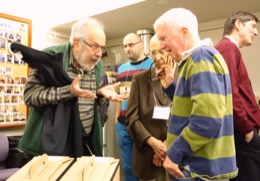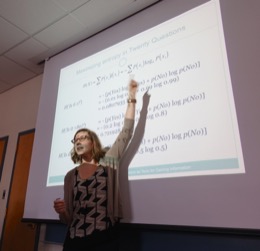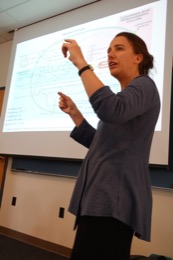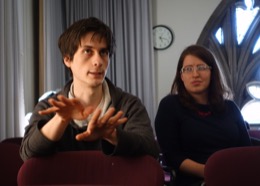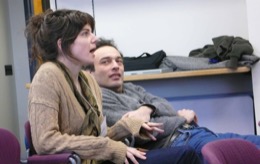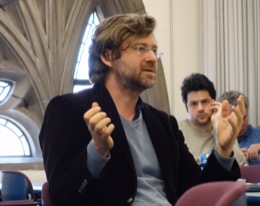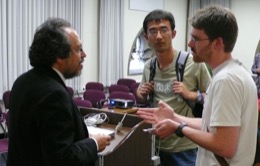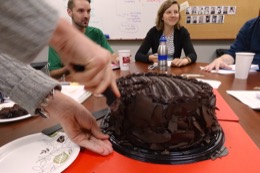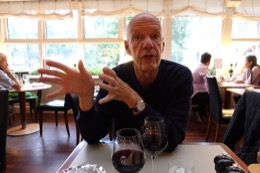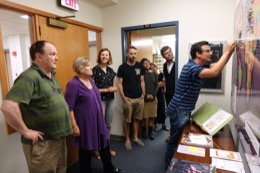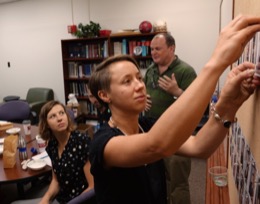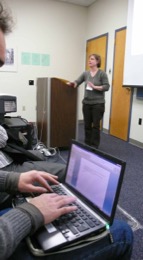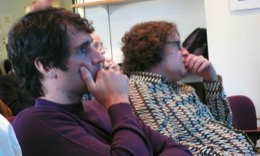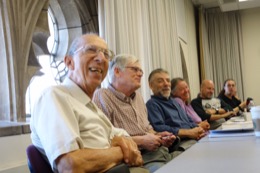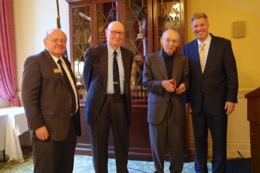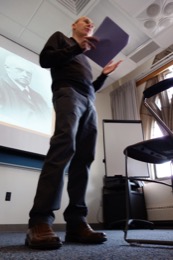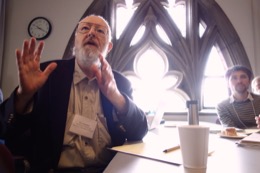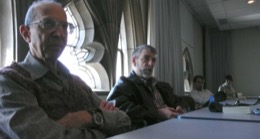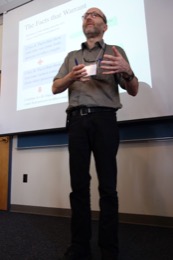

![]()
home
::: about
::: news
::: links
::: giving
::: contact
![]()
events
::: calendar
::: lunchtime
::: annual
lecture series
::: conferences
![]()
people
::: visiting fellows
::: postdoc fellows
::: resident fellows
::: associates
![]()
joining
::: visiting fellowships
::: postdoc fellowships
::: senior fellowships
::: resident fellowships
::: associateships
![]()
being here
::: visiting
::: the last donut
::: photo album
|
How to Photograph a Talk Over the last ten years, I have taken photographs of every Center event that I have attended. The photos have gone into our online photo album or to illustrate the “donuts” pages. The album and donuts pages photos are more than just decoration. Each small image is a link to a high resolution version of the same image. They are a ten year archive of photographs of people and events at the Center. Now that I am leaving the Center’s Directorship, I want to encourage others to take up the job of documenting the Center and its people in photographs. It’s not hard to do. If you are already at the event, it is only a little extra work to keep a camera handy and snap a photo when the opportunity arises. What follows is not for photographers. They already know what to do. It is for novices who do not know where to start. I’ve no illusions that the photos I took are great photos. They are only just good enough. However I’ve learned a few tricks along the way and here are my tips to get novices started. Do this to get 90% of the benefit: • Don’t worry about the camera. You don’t need anything fancy to take quite good photographs. The cameras in cell phones are already surprisingly good; and a slightly better camera is probably already more camera than you can use. • Get close to your subject. This one is so important that I’ll say it again. GET CLOSE TO YOUR SUBJECT. Then, GET CLOSER TO YOUR SUBJECT. This will make all the difference in your photographs. Sit at the front, slightly to one side of the speaker and pop away! You are in the front row. When someone in the second row asks a question, turn to face them and snap! • Take lots of photos. When people speak and you take a photo, you almost certainly will freeze them in some unnatural pose. Even lightning fast reflexes are no assurance that you get a good looking expression. The solution-—the only one I’ve found to work reliably-—is to take lots of photos. When you have your subject lined up perfectly, don’t snap the shutter once. Do it five times. Then perhaps one photo will be a keeper. Do this much and you are well on the way to creating a good photographic record. If that is enough information for you, stop reading here. The bigger picture Do you want to be a little fancier? Then think about the photo you are taking as part of storytelling. All stories need a setting. So at some point, try to get a photo of the whole room. That will likely be a more boring photo. But it is important. It makes the best record of who was there and what the general layout was like. Events involve people doing things. Try to capture them in the moment of the doing.
There are high points and low points in a talk. Often you can capture the high point by juxtaposing a gesturing speaker against a revealing Powerpoint screen. If you want to capture the idea of the speaker speaking to a room, be bold and stand behind the speaker to one side and take a photo over the speaker’s shoulder, seeing what the speaker sees. Do it quickly and no one will mind. It can be difficult to capture a moment. Someone in the audience asking a question, when frozen by the camera, will look like someone just sitting there. You know that they were asking the decisive question, but the camera just doesn’t show it. The best solution I’ve found is to wait until there is some gesture: a hand wave, leaning forward and pointing, etc. Snap that. Better, if there are people nearby watching, include them in the frame. Their bodies will be turned to the questioner and their faces will show what they are thinking of the question. If two people are talking, capture the moment in which you see them looking into each others’ eyes. Don’t be shy about photographing things. A close up of a tray of colorful donuts is always a winner. But the better photo is taken over the tray as someone reaches forward to pick one up.
Larger than life We think that we see things as they really are and then we are disappointed when the photo doesn’t match what we saw. The problem is that we don’t see things as they are. We focus on the bit of our visual field that interests us, blocking out clutter, and we magnify it. We are aware of quite a few moments at once. We see things change, but think of it as one moment in time. The camera does not have our powers. It captures everything, wanted or not, for just one moment. The classic beginner's mistake is not to see the cluttered background. Your subject has a lamp post growing out of his head. You didn’t see it, but the camera did. Pay attention to the background. Be on the lookout for a plain background against which to photograph. When some interesting interaction happens, just raising the camera to your eye will not capture the moment. You have to see all the pieces at once in the frame. If you click the shutter at the most intense moment, you might just get the general sense of things. Composition Every photo is a composition of shapes. Good photos are well composed. Good composition is something of an art and not everyone has a talent for it. Getting good composition at the same time as you document some event is a challenge. It can be done, if you think about composition. Here are few rules of thumb that I’ve found very helpful, because they are easy to implement. • Focus of attention The best photos have a single, dominant thing that immediately draws your attention. It is what the photo is about. Fill the frame with that thing and have smaller things around it compliment it. A photograph of many people having a good time in a room can be boring, unless you have one person or couple in foreground and the rest in the background. Compare this: with: •Repetition Many times, you will see repeated shapes in your image. There is something both strong and calming about it. • Lines Horizontal lines and parallel lines are static and make for a quiet image. Diagonal lines and converging lines are busy and make for an energetic image. The easiest way to get them is with converging perspective lines. • Sizes A sure fire way get a boring photo is to line people up and pop off a shot. Many things will make it boring. The awkward, self-aware posing will be a problem from the start. One contributing problem that will not be immediately obvious is that all the bodies and heads will be the same size in the image. Photograph it from the side and the people nearest the camera will be twice the size of those farther away. That sounds like it will look wrong, but it doesn’t. You won’t even notice the difference in size, but you will feel that the image is more dynamic. Compare: with: •Rule of thirds This is a standard rule that I think is overemphasized. As a default, do not divide your image into two. Divide it into thirds. It will feel more balanced. There. I’ve told you. But don’t waste too much time worrying about it. The Camera Eventually the camera you use will matter. All things equal, a better camera takes a better photo. However all things are rarely equal. The skill of the photographer is by far the more important factor. When should you worry about the camera? You should worry when you are able to pinpoint specifically what your current camera cannot do. Then you should upgrade to a camera that does that thing. What you should not do is go out and buy the biggest, fanciest camera you can find with the mistaken idea that it will somehow transform your photography. More likely it will do the reverse. You will be lugging around a big, noisy monster whose controls are something of a mystery to you. I've found only two elements to matter to photographing talks: • Low light sensitivity. We often need to take photos in rooms dimmed for digital projection. Then we need a camera that is very sensitive to light and one that can tolerate large variations in brightness. If a camera is poor in this area, photos taken in low light will look spotty ("noisy") and the colors will be muted and shifted. The critical factor for low light capacity is the size of the digital sensor. The larger the sensor, the less leakage there is between the individual pixels and clearer the image in low light. A larger sensor, however, comes at a real cost. A larger sensor requires much larger lenses. They come with cameras that are bigger and heavier. For this reason, virtually all the nice, light portable cameras have small sensors and thus give you trouble in low light. • A quiet shutter. To get good photos, you must take lots of them. I can easily take 100 photos at a talk. It's not hard to see why. If there are ten scenes to capture and I take ten snaps each, there's one hundred. If you are to take this many photos, you must have a camera with a quiet shutter. There is an easy guide to finding one with a quiet shutter. The big division in cameras is whether they have interchangeable lenses. Cameras with interchangeable lenses use "focal plane shutters." These are curtains that switch across the sensor at the back of the camera. They have a long way to travel and, as a result, make a lot of noise. Worse, if you get a single lens reflex camera, there is also a mirror that must flip out of the way. We have all seen people taking photos with this sort of camera. The talk is proceeding. You hear a k-clack-k-clack and look around to see the photographer standing there, camera at the eye. Then there's another k-clack-k-clack and, if the photographer is especially bold, a third, before the photographer retreats in shame. Cameras that do not have interchangeable lenses use much smaller "leaf" shutters inside their fixed lenses. They make virtually no noise at all. Indeed some of the cameras add an electronic click to let you know that the photo was taken. To keep the camera as quiet as possible, you should find the menu setting that lets you turn off this feature. Which camera should you buy? I'd recommend any that has the features above. My latest is a Sony RX100 IV, which is a startlingly good camera in a very small size. It has excellent low light performance. It is one of the few cameras that fits a relatively large 1" sensor into a tiny box. It looks so small that subjects do not recognize just how detailed a photo I just took of them. It is tempting to get a camera with a powerful telephoto lens. Then you are able to stand far away and pop off shots in peace. Alas, they generally will not be good photos for the reasons just described to do with composition. A telephoto lens flattens an image. All the people come out the same size and the lines tend to be parallel. A wide angle lens solves the problem. Then you must come in close to fill a frame. You get lots of converging perspective lines and there will automatically be a cascade of people of different sizes in the image. Those closest will be biggest. Those farthest away will be smallest. Here optics work in our favor. Telephoto lenses tend to be big and heavy. Wide angle lenses tend to be smaller and more compact. I recommend choosing the widest of wide you can. My Sony is a "24mm equivalent," which is very wide. It is a zoom lens, as are virtually all non-interchangeable lenses, so I get some telephoto focal lengths. I'd urge you not to worry too much about getting a lot at the telephoto end. If you have a good wide angle lens, you will have to get in closer to your subjects and will automatically take better photos. Bits and Pieces There’s lots more to taking good photos. Here are a few closing thoughts: Vantage point: The general rule is that a photo taken above the subject's eye level makes them look diminished. One taken at eye level is congenial. One taken below eye level makes them look powerful. Hence I favor lower vantage points. Extremely low vantage points can give striking effects. Light: It is all about the light. If you haven’t already, get a sense of the huge difference between photographing into the light and photographing with the light at your back. In the first case, your subjects end up as dark silhouettes. You can help things only a little by purposefully overexposing. In the second, especially if the light is a little diffuse, you get well-formed detailed images. Flash: Try to avoid it. It flattens the image and alarms everyone. It’s the best way to get everyone to freeze and look nervous. If you have persevered to the end, then it should take only a little more encouragement from me to get you to go out and start taking photos. The best way to get better is to take lots of photos and then look critically at what you took. Then, your shots will be better next time and better still the time after. John D. Norton
|
